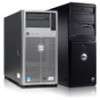Dell PowerEdge T605 Hardware Owner's Manual (PDF) - Page 219
connected and disconnected while the system is running.
 |
View all Dell PowerEdge T605 manuals
Add to My Manuals
Save this manual to your list of manuals |
Page 219 highlights
termination - Some devices (such as the last device at each end of a SCSI cable) must be terminated to prevent reflections and spurious signals in the cable. When such devices are connected in a series, you may need to enable or disable the termination on these devices by changing jumper or switch settings on the devices or by changing settings in the configuration software for the devices. TOE - TCP/IP offload engine. A technology to improve data-transfer performance over IP networks by allowing the operating system to offload all TCP/IP traffic to specialized hardware on the network adapter, while leaving TCP/IP control decisions to the host server. UNIX - Universal Internet Exchange. UNIX, the precursor to Linux, is an operating system written in the C programming language. uplink port - A port on a network hub or switch used to connect to other hubs or switches without requiring a crossover cable. UPS - Uninterruptible power supply. A battery-powered unit that automatically supplies power to your system in the event of an electrical failure. USB - Universal Serial Bus. A USB connector provides a single connection point for multiple USB-compliant devices, such as mice and keyboards. USB devices can be connected and disconnected while the system is running. utility - A program used to manage system resources-memory, disk drives, or printers, for example. UTP - Unshielded twisted pair. A type of wiring used to connect systems in a business or home to a telephone line. V - Volt(s). VAC - Volt(s) alternating current. VDC - Volt(s) direct current. VGA - Video graphics array. VGA and SVGA are video standards for video adapters with greater resolution and color display capabilities than previous standards. Glossary 219















